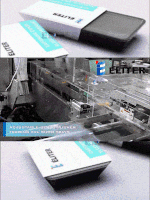Scientists create edible labels capable of storing data
2023-02-10
Researchers develop a system of edible labels housed inside food.
The method, called Interiqr, is developed at Osaka University Japan and consists of the introduction of edible labels inside the food without changing its appearance or taste, the technology uses the 3D printing process to embed a QR code inside the food, thus allowing the label to go unnoticed by the human eye.
By manipulating the inside of the food with a QR code using 3D printing, a filling structure with a specific shape and volumes can be embedded without modifying the taste or size of the food. Mainly, it has been implemented in cookies. “This 3D printing method is an example of the digital transformation of food, which we hope will improve food traceability and safety”” says Kosuke Sato, lead author of the research project.
Technology and innovation in the food industry

QR code embedding process
The study explains that there are many methods of digital food manufacturing which allows creating foods with different characteristics, such as foods that retain their shape without support, deformable foods that expand with contact with water or heat.
Although its main application is the creation of food free of packaging, other alternatives are being explored, such as CoffeeB, a system of coffee capsules that work without packaging and without producing waste, since the coffee is pressed and wrapped in a 100% compostable protective layer. Although many efforts are focused on making food packaging more environmentally friendly, the Interiqr method promises not to use packaging at all.
A viable solution to a pollution-free industry
As time progresses, industries have made greater efforts to reduce their impact on the environment, the food industry has been one of the main pollutants due to its dependence on plastic.
The Interiqr method is proposed as the solution to the use of food packaging, although many companies use packaging to label their food, the research aims to address this environmental problem, incorporating the information in an edible way without the need for packaging. It is expected that this technology will continue to be developed in turn with its multiple applications in the food industry.




